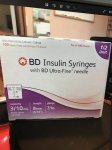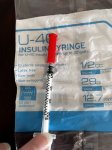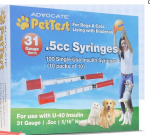@Suzanne & Darcy
I wanted to give you an update on Douglas and ask for your feedback on what I am doing, and my plan going forward.
Douglas had 2 hypo events last week. The one on 3/30/25 afternoon was long lasting and could have been related to him throwing up his dinner the night before. He did not exhibit any hypo symptoms, which I am thankful for. Before doing a "hypo protocol", I always monitor with BG meter, and it was low on the Contour. I gave him high carb food and maple syrup. I also consulted with the video vet. I reduced his dose to 2.5. Then on 4/3/25 evening, he had a very short hypo event. It wasn't as low as the one on the 30th, but I reduced the dose to 2.25 because he seems not to be eating his usual amount of food compared to when he was first diagnosed. He used to eat 6 oz FF classic pate pre-shot, and now he seems to only eat 3 oz. Then I provide food throughout the day with a feeder. Last week, I tested ketones 3x, and they were 0.4, which is great. Previously, when he was on a lower dose of glucose, his ketones were high.
My plan is to leave him on 2.25 for the next 7 days, and monitor his ketones a few times. I need to do a better job of tracking how much he eats. It is a challenge, because I have another cat. Douglas has regained his lost weight back. He is a big guy. He currently weighs 14 lbs. 3 oz. The doctor gave us a target weight of 14 lbs and 4 oz. At one time he was overweight, and we had to put him on a diet. And I found out that diet food is really high carb!
Plan going forward:
I am also thinking about looking for an internal medicine vet who has experience treating diabetic cats. I am going to contact my regular vet and see if they can make a recommendation. I don't know how much experience my current vet office has with treating feline diabetes, but I was told during the initial consultation if they couldn't get him regulated, then they'd refer me to an internal medicine doctor. I think it is now time to try that. Not sure if I will get better results, but I think it would be good to get a different perspective and maybe work with someone who has more experience with treating feline diabetes, especially with one who is not yet regulated.
By the way, we have been using the Freestyle Libre3 for a week now. I love it! It gives me a peace of mind when I am at the office or away from home. With the old Libre2, I couldn't look at his numbers while I was at work, and now I can! I am glad that the vet office is willing to work with me on some things that I am requesting.
In the last email to the vet's office (3/31) the doctor mentioned "I do not ask anyone to monitor their diabetic cat's blood sugar on a daily basis. In most cases we can make appropriate adjustments based on his weight, overall health status (happy and eating well is good), and periodic monitoring of fructosamine levels. I recommend we have a recheck after about 2 weeks of being on the 2.5 unit twice daily insulin dose."
I am working with two doctors at the vet practice, and that was from the "old school" doctor who seems to have a little different perspective from the younger doctor I also work with there. I am interpreting his message as saying that he wants me to bring Douglas in for a fructosamine test around mid April. I am thinking maybe that makes sense if I am working with a new internal medicine doctor, because they will want to see him and probably get some updated lab work done. I am trying to be mindful about taking good care of my boy and not needlessly stressing him out too. He is pretty chill, so going to the vet's office is stressful, but not as bad as for other cats I've known.
I like monitoring my cat's blood sugar on a daily basis, and I am glad he wasn't the first vet I worked with at the vet practice because he may have not recommended the libre. They aren't asking me to monitor the blood glucose, but I want to! And I have learned that it is really important to do so to keep my cat safe. Now that I know more about diabetes, I'd be very uncomfortable about NOT monitoring his BG daily! Especially prior to an injection!
Below are the results for his last test.
fructosamine results
12/31/24: 636
2/22/25: 494
Let me know if you have any feedback on what I am currently doing, or what I plan to do going forward.
Thanks!




